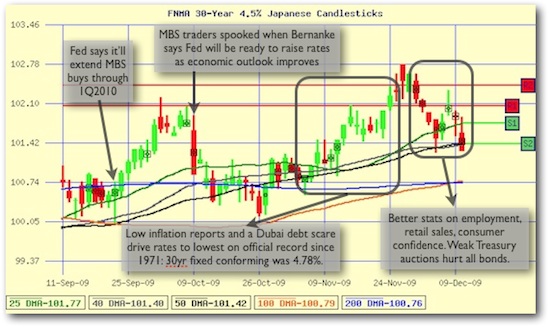Fed Mortgage Bond Program, Sept. 24 to Dec. 9 (weeks 39-49)
This post covers weeks 39 to 49 of a mortgage bond purchase program by the Federal Reserve—it’s normally a weekly post but we took a break to upgrade and relaunch TheBasisPoint … here’s week 38. Between September 24 and December 9, the Fed bought $185.7b net of mortgage bonds—below is a discussion of this 11 week period as well as a summary of the program to date and a tally of where the Fed is with respect to it’s $1.25 trillion program budget.
During this 11 week period, the Fed’s investing focused mostly on 4.5% and 5% coupons, which represent outstanding loans in the 4.75%-5.125% and 5.375%-5.75% ranges respectively. During this time, net purchases averaged $16.88b per week, the Fed hit it’s low for the program with $13.5b net buys November 5-11, and 30yr fixed rates hit an all-time record low. Here is an MBS 4.5% coupon chart for the last quarter with our comments summarizing key events of the period—this is the coupon that most mortgage lenders use to price daily rate sheets. Consumers should note that when the chart shows bond price increases, that means rates drop (and vice versa).

How Long Fed Rate Stimulus Will Last?
The purpose of the Fed mortgage bond buying program is to elevate mortgage bond prices which pushes rates down. It’s very likely that the November 25 record rate low will remain the record low. The Fed will continue buying through March 31, 2010 until they reach their $1.25t budget (see program-to-date tally below), but as we approach the end of 2009 and move through 1Q2010, we’re likely to see private mortgage bond investors trimming positions which also creates upward rate pressure.
The money manager strategy since the Fed MBS program was announced in November 2008 (and implemented January 1, 2009) has been to buy MBS ahead of Fed buying and sell at a profit before the Fed does. So if the money mangers start selling mortgage bonds as we get closer to March 31, 2010, and also the Fed starts selling when the economy improves, that will create potentially sharp upward rate pressure.
Market sentiment shifts wildly as all global market participants furiously try to reconcile where we’re headed. Economic news is generally improving which can cause upward rate pressure as investors move from bonds to stocks. The Treasury supply to raise money for the nearly-$1t stimulus package passed earlier in 2009 continues to pose a threat to mortgage bond prices as well. And word from FOMC members only contributes to volatility. This is from the October 14 meeting minutes:
With respect to the large-scale asset purchase programs, some members thought that an increase in the maximum amount of the Committee’s purchases of agency MBS could help to reduce economic slack more quickly than in the baseline outlook. Another member believed that the recent improvement in the economic outlook could warrant a reduction in the Committee’s maximum purchases. However, all members were able to support an indication by the Committee of its intention at this time to purchase the full $1.25 trillion of agency MBS that it had previously established as the maximum for this program. The Committee agreed that it would continue to evaluate the timing and overall amounts of its purchases of securities in light of the evolving economic outlook and conditions in financial markets. Members discussed the importance of maintaining flexibility to expand the asset purchase programs should the economic outlook deteriorate or to scale back the programs should economic and financial conditions improve more than anticipated.
These comments make the Fed sound like just another market participant. But they’re calling the shots too with respect to rates. That’s why we have so much volatility.
What Mortgage Bond Buying Means for Rates And Consumers
We cover the Fed mortgage bond buying closely to try to help consumers make decisions but the gist is: rates are at all-time lows, so if you can get the right price on a property purchase you’ll get a record low rate to go with it. And if you’re looking to refi, your window is closing. As we move into 1Q2010, we’re likely to see rates rise as private mortgage bond investors sell holdings.
Also see this report for an easy to understand description of the Fed program and what it means for consumers, keeping in mind the rates referenced in that piece are dated (and rates change all day everyday as mortgage bonds trade).
Tally Of Mortgage Bonds Bought By Fed
The Fed, according to their own reporting, has bought $1.08t net of mortgage bonds, which is 86.43% of their allotted $1.25t target by March 2010. This isn’t an official number, it is a close tally The Basis Point has kept of net MBS purchases since the Fed began buying in January 2009. Here’s the current and detailed report of the Fed’s MBS holdings.
